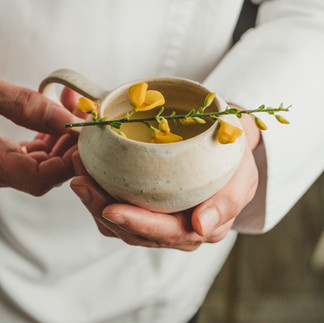A day in the mountains… with a tasting menu that has a story to tell.
- MANU FRANCO

- Oct 26
- 3 min read
Why do we have a tasting menu in our restaurant?
Flavor, history, beauty, and emotion.
Since mid-2021, when I decided to keep spinning the wheel of risk and throw ourselves off the cliff with toy wings—yet determined to build them step by step, minute by minute, with courage, passion, effort, and a small dose of talent—La Casa de Manolo Franco has offered a tasting menu.
These days, tasting menus and what many call “storytelling” are often criticized from several fronts:
That you can’t choose, that it’s about the chef’s ego, that it’s imposed, boring, tedious, too long… those are some of the so-called “arguments” used to discredit this proposal.
It’s curious, though, that criticism arises when creativity and creation have been the very reasons Spanish cuisine has reached such great heights.
But beyond that reflection—whether you agree or not—I want to tell you why our house embraces this concept. It’s based on four words:
1. Need
An artist once said, “It’s not that it’s my job, it’s that it’s my language.” That’s exactly it. I remember when I was a journalist, how many times people tried to change the way I wrote. And I tried too. But I couldn’t. In the kitchen, it’s the same. This is what I want to do: to try to move people through gastronomy, through dishes, through the stories some of them tell. And it’s the way I know—or try—to do it. Also, coming to our house, for some people, is a kind of need. Not a basic one, of course, but the need to live a different, unique moment—to find calm, peace, to feel cared for and special, happy…
2. Happiness
The ultimate goal is always the happiness of the guest—the person who comes to see us should leave happy.
And the way I try to achieve that is through this concept that unites gastronomy and literature—food for the stomach and for the soul. That’s why we aim to offer the best service, with the best possible ingredients, treated with all the care we know how to give. Not every dish tells a story, but each has a reason. Some are there simply because of the season or what’s available at the market, while others speak of memory…
3. Legacy
This restaurant is an act of love for my family, for my father—hence its name. But it’s also for this town, its surroundings, for Madrid and the mountains, for our ancestors. I want to carry their legacy as far as possible, and above all, into the memory of those who visit us. That’s why our appetizers are based on the traditional tapas from my parents’ and sisters’ Casa Manolo, the rice pudding is the one my father used to make, the fig leaf dessert honors my aunt Santa—the village postwoman and an exemplary woman—and the churros come from my uncles Pichi and Ricardo, the town’s churreros…
4. Emotion
Everything is for the guest—and for their emotion. I know this isn’t a restaurant to visit every weekend, that coming here is a kind of luxury. But when you do come, just as you might go to a grill house, a pizzeria, or a traditional à la carte restaurant expecting to feel satisfied—here, I need you to leave moved. At some point, I hope our dishes, our story, our words—whether on paper or on the plate—take you somewhere, make you feel. And that you are touched.
Achieving all this isn’t easy, and I know it means going against the current.
But it’s ours—what we want, and what, I hope for a long time, our guests will continue to want from us.
Perhaps because they, too, feel the need for a unique moment—to be happy, to live a legacy, and to leave deeply moved…
M.Franco
















Comments